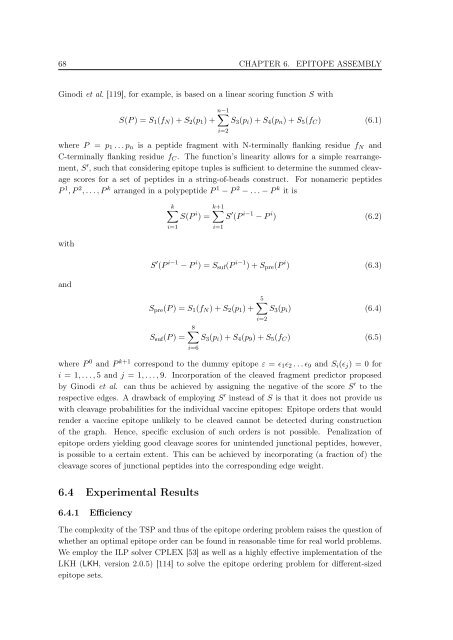New Approaches to in silico Design of Epitope-Based Vaccines
New Approaches to in silico Design of Epitope-Based Vaccines
New Approaches to in silico Design of Epitope-Based Vaccines
You also want an ePaper? Increase the reach of your titles
YUMPU automatically turns print PDFs into web optimized ePapers that Google loves.
68 CHAPTER 6. EPITOPE ASSEMBLY<br />
G<strong>in</strong>odi et al. [119], for example, is based on a l<strong>in</strong>ear scor<strong>in</strong>g function S with<br />
n−1 <br />
S(P ) = S1(fN) + S2(p1) + S3(pi) + S4(pn) + S5(fC) (6.1)<br />
i=2<br />
where P = p1 . . . pn is a peptide fragment with N-term<strong>in</strong>ally flank<strong>in</strong>g residue fN and<br />
C-term<strong>in</strong>ally flank<strong>in</strong>g residue fC. The function’s l<strong>in</strong>earity allows for a simple rearrangement,<br />
S ′ , such that consider<strong>in</strong>g epi<strong>to</strong>pe tuples is sufficient <strong>to</strong> determ<strong>in</strong>e the summed cleavage<br />
scores for a set <strong>of</strong> peptides <strong>in</strong> a str<strong>in</strong>g-<strong>of</strong>-beads construct. For nonameric peptides<br />
P 1 , P 2 , . . . , P k arranged <strong>in</strong> a polypeptide P 1 − P 2 − . . . − P k it is<br />
with<br />
and<br />
k<br />
S(P i k+1<br />
) =<br />
i=1<br />
i=1<br />
S ′ (P i−1 − P i ) (6.2)<br />
S ′ (P i−1 − P i ) = Ssuf(P i−1 ) + Spre(P i ) (6.3)<br />
Spre(P ) = S1(fN) + S2(p1) +<br />
Ssuf(P ) =<br />
5<br />
S3(pi) (6.4)<br />
i=2<br />
8<br />
S3(pi) + S4(p9) + S5(fC) (6.5)<br />
i=6<br />
where P 0 and P k+1 correspond <strong>to</strong> the dummy epi<strong>to</strong>pe ε = ɛ1ɛ2 . . . ɛ9 and Si(ɛj) = 0 for<br />
i = 1, . . . , 5 and j = 1, . . . , 9. Incorporation <strong>of</strong> the cleaved fragment predic<strong>to</strong>r proposed<br />
by G<strong>in</strong>odi et al. can thus be achieved by assign<strong>in</strong>g the negative <strong>of</strong> the score S ′ <strong>to</strong> the<br />
respective edges. A drawback <strong>of</strong> employ<strong>in</strong>g S ′ <strong>in</strong>stead <strong>of</strong> S is that it does not provide us<br />
with cleavage probabilities for the <strong>in</strong>dividual vacc<strong>in</strong>e epi<strong>to</strong>pes: Epi<strong>to</strong>pe orders that would<br />
render a vacc<strong>in</strong>e epi<strong>to</strong>pe unlikely <strong>to</strong> be cleaved cannot be detected dur<strong>in</strong>g construction<br />
<strong>of</strong> the graph. Hence, specific exclusion <strong>of</strong> such orders is not possible. Penalization <strong>of</strong><br />
epi<strong>to</strong>pe orders yield<strong>in</strong>g good cleavage scores for un<strong>in</strong>tended junctional peptides, however,<br />
is possible <strong>to</strong> a certa<strong>in</strong> extent. This can be achieved by <strong>in</strong>corporat<strong>in</strong>g (a fraction <strong>of</strong>) the<br />
cleavage scores <strong>of</strong> junctional peptides <strong>in</strong><strong>to</strong> the correspond<strong>in</strong>g edge weight.<br />
6.4 Experimental Results<br />
6.4.1 Efficiency<br />
The complexity <strong>of</strong> the TSP and thus <strong>of</strong> the epi<strong>to</strong>pe order<strong>in</strong>g problem raises the question <strong>of</strong><br />
whether an optimal epi<strong>to</strong>pe order can be found <strong>in</strong> reasonable time for real world problems.<br />
We employ the ILP solver CPLEX [53] as well as a highly effective implementation <strong>of</strong> the<br />
LKH (LKH, version 2.0.5) [114] <strong>to</strong> solve the epi<strong>to</strong>pe order<strong>in</strong>g problem for different-sized<br />
epi<strong>to</strong>pe sets.

















